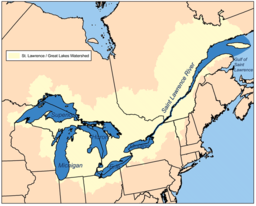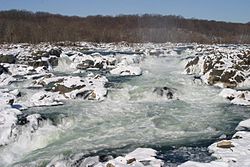The Spaniard Pedro Menendez complained of the southern infringements by the French to King Phillip ll. He angrily reported, " In 1565 and for some years previous, buffalo-skins were brought down the Potomac River and there carried along shore in canoes to the French about the Gulf of St Lawrence. During two years 6000 skins were thus obtained. "
| Saint Lawrence River | |
| Fleuve Saint-Laurent | |
|
St. Lawrence River near Alexandria Bay
| |
| Countries | Canada, United States |
|---|---|
| State/Provinces | Ontario, Quebec, New York |
| Source | Lake Ontario |
| - location | Kingston, Ontario / Cape Vincent, New York |
| - elevation | 74.7 m (245 ft) |
| - coordinates | 44°06′N 76°24′W / 44.100°N 76.400°W |
| Mouth | Gulf of St. Lawrence / Atlantic Ocean |
| - elevation | 0 m (0 ft) |
| - coordinates | 49°30′N 64°30′W / 49.500°N 64.500°W |
| Length | 1,197 km (744 mi) |
| Basin | 1,344,200 km2 (519,000 sq mi) [1] |
| Discharge | for below the Saguenay River |
| - average | 16,800 m3/s (590,000 cu ft/s) [2] |
----------------------------------------------------
The Potomac River in the heart of the
Bison's historical Eastern USA home.
The Saint Lawrence River was the exit
point to the Atlantic Ocean for
the Portugeese and French to get their
Bison Skins back to the Old World
| Potomac River (Wappatomaka) | |
|
Great Falls of the Potomac River in winter.
| |
| Country | United States |
|---|---|
| States | West Virginia, Maryland, Virginia, Washington, D.C. |
| Tributaries | |
| - left | Monocacy River, Anacostia River |
| - right | Shenandoah River, Occoquan River |
| Cities | Harpers Ferry, WV, Cumberland, MD, Washington, D.C., Arlington, VA, Alexandria, VA |
| Source | Fairfax Stone |
| - elevation | 3,060 ft (933 m) |
| - coordinates | 39°11′43″N 79°29′28″W / 39.19528°N 79.49111°W |
| Mouth | Chesapeake Bay |
| - location | St. Mary's County, Maryland / Northumberland County, Virginia, USA |
| - elevation | 0 ft (0 m) |
| - coordinates | 37°59′57″N 76°14′59″W / 37.99917°N 76.24972°W |
| Length | 405 mi (652 km) |



















4 comments:
Rick, for a few months now, I've been trying to get a specimen tested that may help determine whether grey wolves and red wolves interbred historically. There's a wolf listed as Canis rufus floridianus that was found in New Morgue cave near Huntsville, AL. back in the 70's. It appears to be several hundred years old (pre western coyote?). I am looking for someone to partner with to retest this specimen (never found results from first test from 2002) and as I'm not an academic (yet) I can't ask to have it tested myself. Any suggestions on who to approach with this project?
....Another good source of information about "buffalo" in the Eastern U. S. is John Lawson, in his book "New Voyage To Carolina". He was an early explorer who penetrated only about halfway inland from the coast in the present states of both North and South Carolina, and reports buffalo/bison. The erroneous view that the East was one great, unbroken forest is common, but inaccurate. The Indians purposefully burned vast stretches to create open areas for game they were dependent on--bison, elk, white-tail deer, cottontail rabbit, bobwhite quail, wild turkey--ALL are wildlife present in the East in great numbers that prefer "edge" environments. There are many native plants and flowers and grasses that only thrive in open, savannah-type environments that were also present in the East, as recorded by early botanists. Once large areas were cleared by Indian-set or lightning-started fires, large grazing animals like Bison and Elk tended to keep them that way. I might add, incidentally(in connection with an earlier post), that all this was also excellent potential RED FOX habitat, and I believe native red foxes were probably much more widespread throughout the East prior to the European introductions(people as well as foxes!) than is presently accepted. If you read about the NATIVE history of North America(I recommend a great comprehensive, enlightening book entitled "1491"), it becomes apparent that an enormous percentage of the native population died off after the earliest explorers like Desoto penetrated North America, due to diseases they-se explorers introduced, that the natives had no resistance too. Entire societies were depopulated and collapsed, and the forests had a couple of centuries to regrow before the European settlers began their expansion West. These Europeans got the impression that the East was one vast, unbroken forest, an impression that lives on to this day. Even then, there were still large clearings with buffalo and elk, etc. And gray wolves. And red foxes--or so I theorize......L.B.
L.B...............right on about the Indian population crashing post initial EXPLORER contact..........and the meadows regrowing back into woodlands.............with still many open patches that Bison thrived on...........And these Bison were likely wood bison---certainly they were comfortable dealing and thriving in "edge" environments
Mark.........Try contacting the following Eastern USA Coyote and Wolf Biologists
Jon Way-Massachusetts
easterncoyoteresearch@yahoo.com
Roland Kays-North Carolina
toland_kays@ncsu.edu or roland.kays@naturalsciences.org
--------------------------------
Trent University Ontario Canada wolf and Coyote biologists are outstanding to contact as well
lrutledge@trentu.ca(Linda Rutledge)
bradley.white@nrdpfc.ca
twheeldon@gmail.com(Tyler Wheeldon)
dennismurray@trentu.ca
brent.patterson@ontario.ca
---------------------------
Please mention my name when writing to them-----good luck with your research
Post a Comment